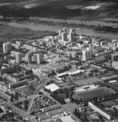history educational sustainability public policies representation surveys & analyses fabrication urban practices local development open spaces urban renewal rigenerazione urbana Community innovation ecological networks social housing waterfronts & harbors città storica democrazia networks giornata di studi inu cities smart city premio gubbio 2018 large scale plans & projects
Etude de cas. Contribution au concours “Ville et Immigration”
by Mallory Reveau
Mantes la Jolie is situated 50 Km from Paris and constitutes the west extremity of the Paris region. After a phase of reconstruction of the city centre, which was destroyed during the second world war, the Mantes la Jolie urban development was quick and sudden. In 20 years, the city has changed from a provincial town's status to a suburban status. Built to answer the car industry needs, Val Fourré's main purpose was to accommodate immigrant workers first, then their family. Quickly, a part of the first Val Fourré residents set up in the outskirts, where houses in the suburb had been built. Considering the low level of rental in public and private housing units, the site of Val Fourré, remains attractive, though, for people who could find no accomodation in the Paris suburbs. Among these newcomers, many are foreigners ( the immigrated population represented 44.4 % of the population of Val Fourré in 1998, about 10,600 persons, which is far above the regional average (13 %).
Distribution of the immigrated population
The foreign population is inequally distributed over the town. Thus in 1990, the part of foreigners was low in Mantes la Jolie ( lower than 10 %) inside and around the older town, moderate in other areas - except Val Fourré - and strong to very strong in the public housing area, where it exceeds globally 40 %.
However, inside Val Fourré, there are disparities. The part of Foreigners is low in the Physiciens area (12 %), but reaches almost 80 % in the Ecrivains area which is run by Logement Français. It exceeds also 50 % in a large section of the 'ZUP' (a french acronym for Zone à Urbaniser en Priorité : Priority Zone to be Developed) ( Peintres, Explorateurs et Musiciens).
One area but a vast number of ethnic groups
The qualificative 'foreigner' is too global because it hides in fact a complex social reality and so it is difficult to understand all the subtleties it covers.
Indeed, among the "foreigners", we can number more than a hundred different nationalities and cultures. The Maghreb, and in particular, Morocco, represent the principal origin of foreign couples of Val Fourré (55%). It includes a great proportion of western black Africans (14%). The many other nationalities account for 30 % of immigrated couples in Val Fourré.
Currently, Val Fourré can be called an "anti ghetto" area as its population does not present the cultural unit of only one ethnic group ( one of the criterion used to define a ghetto).
The social behaviour and the level of integration are variable and depend notably on the time spent since immigration and on the nature of the environment ( urban or rural).
The identification of processes, notably among the young, are more in keeping with a 'my block of flats' and 'my district' attitude than with culture or nationality. We can say that this situation is rather positive, people say " we are 'Peintres' or 'Ecrivains' rather than we are Moroccan or Congolese. Val Fourré thus plays an equalitarian part which is unexpected but preferable to the emergence of ethnic tensions.
The question of community withdrawal
Moreover, there are other phenomena or mechanisms that are not highlighted by statistics.
Recent social studies on certain Val Fourré districts tackle in particular the importance of community withdrawal, that is to say a withdrawn attitude that values the culture and the ethnic group, which triggers off a come back to the social customs of the original community and a come back to religion and religious beliefs. The lack of integration for these areas will consequently favour such community withdrawal, as only the communities will be able to give an answer and effective help to people who meet difficulties.
This development of religion signals the come back of community culture. Because of a great number of Moslems in Val Fourré and because Islam is present everywhere. According to all the local social services, religious practices in the area seem to gain in importance and are increasing. There are about 5,000 people regularly going to the 3 Mosques in the area. Such situation entails cultural and religious behaviours, like women wearing veils for example.
These questions, however, are quite debated upon by the local actors in the area and no firm conclusion can be reached in any way.
Now, the question is to know if such community withdrawal is real or not, considering the vast number of immigrants living in the area. Certain studies by American sociologists, demonstrate that a good integration in one's community favours a good integration in the society.
The "Big Mosque" in Val Fourré which is located along the railway line, is affiliated to the Islam Union of Yvelines, which corresponds to official Islam in France. It is said to gather 2,000 persons regularly. Inside this Mosque there is a coranic school, which teaches lessons to 500 children. The "Tabliks" are a group who have met a great success because they have managed to involve former offenders in their spirituality. The Turk community have equally their church office where North and black African communities go to. The message of this cult is nationalistic and religious. The cult of the third community is the "Souffi" one which welcomes black Africans ( 4,000 persons). The message is moderate, non violent and they are very demonstrative in their cult. But on the other hand, there are more political and extremist groups, certain persons of which are linked with the GIA. The development of the moslem cult in Val Fourré is not a problem in itself. But however, one can wonder about the systematic appeal to refuse to acknowledge the western way of life in the Mosques.
The social pressure is important in Val Fourré. In the future, it will be difficult to practise any other religion than the moslem one. Cafés in Val Fourré sell less alcohol and players (loto, ..)have become scarce.
The functioning of public space in certain areas inside Val Fourré is more indebted by community rules : separation between men and women… Only the mall "mantes " can be considered a normal public space, in the sense that this mall receives all the people whatever their religion, sex…
The positive point of community withdrawal is that it keeps "Social peace". The authority noticed a 40 % drop in the crime rate in Val Fourré between 1998 and 1999.
For women, living in Val Fourré, means that they have to be submitted to the community's laws. Sometimes wearing a veil is the sign of the community pressure's on families (on the part of husbands (and fathers?) in particular).
The freedom that an immigrant can take in relation to his original culture is not the same for everybody. One immigrant who is in precarious situation must respect the customs of his circle when he has enjoyed its solidarity. The situation is different when a person has economic independence. The young who fails at school or has professional insertion difficulties, or is unemployed, seeks refuge and his identity within his original culture.
At last, the expansion of religious practice which is segmented according to different origins in Val Fourré, could consolidate ethnic tension, especially between Turks, North Africans and black Africans.
The presence and the influence of communities generate: an attractive effect for certain families who seek a support and help through community withdrawal; a repulsive effect of the district for families who do not wish to be linked with them.
For this last case, the only lasting solution is to leave Val Fourré.




Planum
The Journal of Urbanism
ISSN 1723-0993
owned by
Istituto Nazionale di Urbanistica
published by
Planum Association
ISSN 1723-0993 | Registered at Court of Rome 4/12/2001, num. 514/2001
Web site realized by ChannelWeb & Planum Association | Powered by BEdita 3


